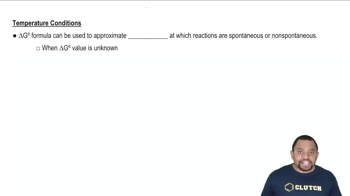Here are the essential concepts you must grasp in order to answer the question correctly.
Standard Free Energy Change (ΔG°)
The standard free energy change, ΔG°, is the change in free energy under standard conditions (1 M concentration, 1 atm pressure, and a specified temperature, usually 25°C). It indicates the spontaneity of a reaction; a negative ΔG° suggests that the reaction is spontaneous under standard conditions, while a positive ΔG° indicates non-spontaneity.
Recommended video:
Standard Gibbs Free Energy and Temperature
Gibbs Free Energy (ΔG)
Gibbs free energy, ΔG, represents the change in free energy for a process at any given set of conditions. It accounts for the actual concentrations of reactants and products, and it determines whether a reaction is spontaneous at those conditions. A negative ΔG indicates spontaneity, while a positive ΔG indicates that the reaction is non-spontaneous.
Recommended video:
Gibbs Free Energy of Reactions
Activation Energy and Reaction Rate
Activation energy is the minimum energy required for a reaction to occur. A large and negative ΔG indicates that a reaction is thermodynamically favorable, but it does not necessarily correlate with a low activation barrier. The activation barrier can still be high, meaning that even favorable reactions may proceed slowly if the energy required to initiate them is significant.
Recommended video:





